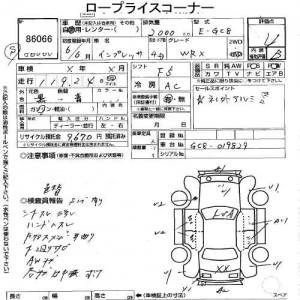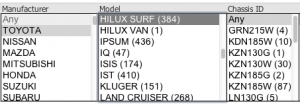My Import Story, Part 2
So, last week I talked about how to start importing a car, which really just starts with the dream of importing a car. This week, we move in to the real details.
Know somebody that knows somebody
I was lucky enough to know a few people that imported their cars, and they coached me on who to choose for an auction agent. Now, there's a lot of options here. Each auction agent runs their business a little differently, charging for different things. Also, some of the auction agents maybe aren't so hot at speaking/typing/communicating in English.
For instance, J-cars charges for rates for each car you bid on, charges an inspection fee, charges for inland freight (that's moving the car from the auction to the boat). This type of setup is quite confusing, but you only pay for what you use... so it could be cheaper to go this route.
I used Brave Auto International. The Director, Mark, is on jdmvip, ivoac and is.... British (I think)! I looked over a couple of options, and reviews of a few places... and Mark seems to run a tight ship, and really know what he's talking about. Note that I'm not getting paid to say this. Mark only does 'CIF' bidding (cargo, insurance, freight). Which brings us to the next point.
Know what you're paying for
I just said Brave Auto does CIF bidding... what that means is that 'everything' is included in your bid. So the bidding at Brave Auto includes:
- Buying the car
- Moving it to his shop (inland freight included)
- Having him look it over and send you ~100 photos
- Cleaning fee (no dirt allowed into Canada... if your car is dirty, they'll send it back!)
- Insurance on the boat
- Stuffing fee (putting it into a container... not as easy as you'd think)
- Pay the boat to actually take the car
You don't need to pay a bidding fee per car, but you also don't get to see EXACTLY how much you pay for the car. This is good and bad. Mark is not going to rip you off, but it's unclear how much you pay for what.
On the plus side, Mark tells you what he thinks of a car... without mincing words. Mark DOES NOT buy crap for you... this is worth a lot in the long run.
Also, Mark ships the cars he buys in his own containers.... not RO/RO (roll on/roll off). This means your car is safer from theft of your car, or stuff in your car.... or parts. Shipping is a thing of it's own... we'll get to that later.
Not all auction agents bid or ship this way. Some agents you will tell the bid for the car, then they'll charge you inland freight (moving the car to the boat), stuffing fees, insurance fees and cargo fees (that's paying the boat to take your car). This is fine, but you NEED to know what services are included before you just go and bid on a car.
Pay the man!
There's a lot of interest in cars, especially in importing really nice cars. All the bidding places are hammered with 14-year-olds with $100 that want to buy an R34 Skyline. The bidding agents need to know if you're serious. That's why all of them ask for a deposit. Usually the deposit is about $1000, but might be more if you're bidding on a seriously expensive car.
Know what you're bidding on!
The auction sheets are in Japanese.... not super useful if you don't speak Japanese.
There's still a lot of information you can glean from the datasheet, despite the fact you can't _actually_ read what it says.
There's more details here on this... and will probably be more later, as this is a HUGE part of the auction process.
Bidding Starto!
That might be 'bidingu starto'. Which is the broadcasted over the intercom in the actual auction houses.
Each auction is about.... a minute. So what you need to do is tell your auction agent what your MAXIMUM bid will be BEFORE the auction starts. Most ask for it hours in advance so they don't have to constantly be checking their email all day for last minute bids.
Remember to bid knowing what your auction fees will be. I always bidded CIF, so the amount I said would be the total amount I'd be paying to get it to the border in Vancouver. You may or may not have to pay more fees on top of this. Make SURE you know how much you're spending before you sign up to pay it.
When it's done, it's done
So, you've bid on a car and won! It's yours now. You're on the hook for the money. If you back out now, your auction agent is stuck with the car... and will be VERY grumpy. They can, of course, put it back on the auction and sell it... but they sure don't want to have to do that.
Next week... after you win!
rob
My Import Story, Part 1
If you follow this blog regularly, you'll know I recently imported a car from Japan. This is my story. I'll talk about how to import in general, then tell you how I went about it.
In the beginning...
I had owned my first right hand drive for about two years, and I wanted something a little more. My Hijet was cool and all, but I have family out-of-town that I should visit, and I just couldn't get myself to drive my itsy bitsy truck out that far. The Hijet could do highway, but it's like whipping a puppy to do it.
I had previously thought about importing something from Japan, but didn't have the nerve to do it. I even said to my wife, "I'd never import a car from Japan myself... that's way too much risk for me." Yeah. And that was my true feelings at the time.
Over time, my feelings changed about importing myself. People I've met (largely through this website) who have imported their own cars encouraged me, and helped me understand the risks, benefits and joy to be had when importing your own car.
So, with my little support group, a small pile of money and dreams of owning a 'new' car, I started the process.
Off to the races
Step 1... do your research.
Yes, hypothetically you could go to ebay.jp, buy a car and ship it. But you'd be stupid to do that. Know what you're getting into, and where to find the good cars.
In short, almost all the cars shipped to Canada from Japan come from the Japanese car auctions. It's Monday morning as I write this... and there's 64000 cars up for auction right now. Check out my previous posts How Auctions work, and Right hand drive auctions - a walkthrough for more details, but in short... the auctions last less than a minute each. It's nuts. In that minute, any car could sell, whether it's a $100000 Ferrari or a $100 minitruck... heck, I've seen rascal scooters on there (seriously... look under "Other", subgroup... "other").
Step 2... Know what you want
I'm guilty of not doing this. I was looking for a "AWD Turbo"... so.... Lancer EVOs, Imprezas, Hilux Surfs, Pajeroes, Legacies.... the list goes on. Not such a great idea.
So, know what vehicle you want, what body style, what colour (if you care), what 'grade' you want (we'll talk about that later), how many kms... and how much you want to pay. The last one is the hardest... again, later.
This is probably one of the hardest steps. The auctions are layed out in terms of Auto Maker->Car name->Chassis code... which is pretty confusing. Probably spend some time perusing the site before you start bidding... Really understand what you're looking at.
Next week... finding an auction agent and more!
Rob


